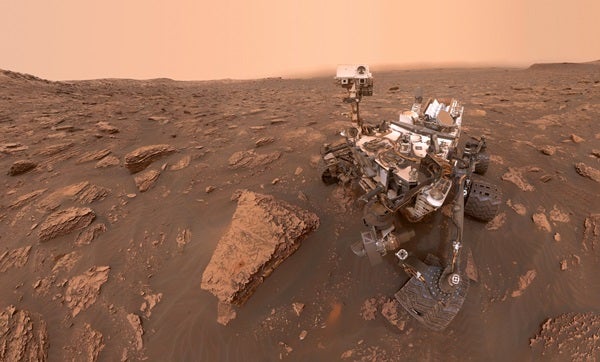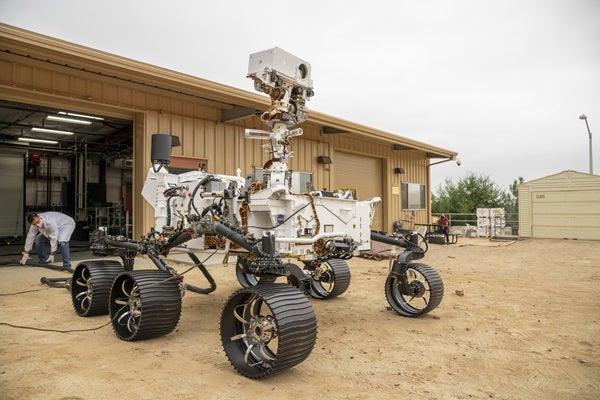Today, more people than ever are working remotely, managing their projects and submitting reports from afar. But there are a select few who have the most extreme version of remote work imaginable: piloting a complex, cutting-edge machine sitting on another world.
These are Mars rover drivers, who are responsible for guiding the most expensive cars to ever be designed, built, and exported off-planet.
Though some might think that driving across martian terrain is a heart-pumping, adrenaline-fueled activity, the reality is a bit more complicated. Far from bounding across the surface and kicking up trails of dust — as Apollo astronauts did in their lunar rovers — the driver of a Mars rover must carefully choreograph every turn of the wheels. It can take up to 20 minutes or more for commands from Earth to reach Mars, and just as long before drivers learn whether the rover has safely executed those commands. Mars rover drivers also work decidedly non-standard hours: Shifts are based on martian time, which slips forward by 40 minutes every day relative to Earth.
But the thrill of exploration is well worth it, according to those who have the otherworldly job.
“There were times when we were crawling along a crater rim, taking close-up pictures of everything we saw, to read the history of the terrain the crater cut into,” says Scott Maxwell, who drove both the Spirit and Opportunity rovers during the Mars Exploration Rover (MER) mission. “There were weeks where we were using the robotic arm’s instruments to study the history of one particularly interesting rock. … And then there were the weeks when we were just driving like a bat out of martian hell to get to the next destination. One of the great things about this kind of exploration is that there’s always something new.”
Driving with care
Officially titled Rover Planners (RP), rover drivers are initially sidelined after a rover touches down. But once the engineering team has tested out the instruments and the science team has collected initial data, the reins are handed over to the RPs.
There are always at least two or three drivers at the helm of any rover, and occasionally more if additional expertise or assistance is needed. Generally, the person designated as RP-1 takes the lead, constructing sequences of moves, while the person designated as RP-2 acts as an advisor and consultant to RP-1.
When sending commands to a rover on a planet as far as 240 million miles (390 million kilometers) from Earth, schedules can be extremely tight. To map out complex moves, drivers use software created at NASA’s Jet Propulsion Laboratory (JPL) to make a 3-D replica of the martian terrain using navigation camera images and a computer program that simulates the actual movement of the rover. They must then program the rover movement each day (or even a few days in advance) to run the command sequence for the target.
To make sure complicated sequences are carried out as planned, drivers may simulate their maneuvers up to 20 times to find the best course of action based on the terrain and soil conditions. Sometimes, they may simulate their moves with a full-scale rover model in a test bed — an outdoor “sandbox” with dirt and rocks that simulates the martian surface.
“It’s kind of up to us to figure out how to do it safely, or even if we can do it safely,” says Heather Justice, a driver for the Perseverance and MER who has worked at NASA since 2011. “We’ll coordinate with [the science team] to figure out exactly where they want to go. And then [the drivers] spend time trying to figure out what’s the way to make sure we’re getting there safely.”
Getting it right the first time is extremely important. It takes multiple meetings, checks and double-checks to decide the course of action after targets are acquired. These procedures are critically important, lest one drive a multi-billion-dollar rover off into a crater.
“Now let’s say you get paid $100,000 a year and you work for 40 years,” remarks Maxwell. “That’s $4 million. In some sense, ‘blowing a sol’— making a single mistake that messed up a day on Mars — would wipe out something in the neighborhood of all the value you would generate over your working lifetime. Oh, not to mention that you’re in charge of one of humanity’s most priceless assets and that screwing it up could be an incalculable failure, far beyond what can be measured in mere dollars.”
Learning to live on a new schedule is also part of a driver’s duties. With a sol — or a martian day — clocking in almost 40 minutes longer than an Earth day, drivers must alter their daily routines and body clocks to match. But losing one’s sense of a day and a consistent schedule can be well worth the price.
“[Living on Mars time] emphasized the uniqueness and specialness of what we were doing,” said Maxwell. “We were the only people on the planet who were coming to work every day on the schedule of another planet!”
Roving upgrades
Over time, with updated technology and better knowledge of the Red Planet, rover driving has changed. Prior to Perseverance, work was more manual, with sequencing done by hand. Now, drivers are more able to precisely and safely take control through a system called Automatic Navigation (AutoNav), an autonomous driving mode that helps the rover reach specific martian coordinates. Think a self-driving car.
“Using AutoNav, we’ll be able to just tell the rover that we want to drive to this point really far away, and just let it kind of take its own images and figure out what’s the safest way to get there,” says Justice. “On MER, much of our sequence building was very manual — for example, typing out individual drive commands. But now we’re relying on tools that are more visual, where we can point to each spot on the terrain and specify a few parameters and it will automatically generate the desired commands for us to review. The fidelity of our simulation tools has really improved over previous missions.”
Justice says that the driver’s software makes it easier for scientists and engineers to communicate and agree on where to send the rover. She says this has been especially helpful since the COVID-19 pandemic, which forced teams to work with the project’s scientists remotely.
“We have this whole big space that was beautifully designed for all these team members who were supposed to be in the lab together,” she says. “Now, however, we’re not all able to huddle around a computer and have someone point to an interesting rock which might make a good target. So it’s a little awkward, but you make it work.”
So, for all the recognition that rightfully goes to the engineers and scientists, make sure to give the drivers their due credit too. After all, without drivers, a multi-billion-dollar rover is just another lander.












